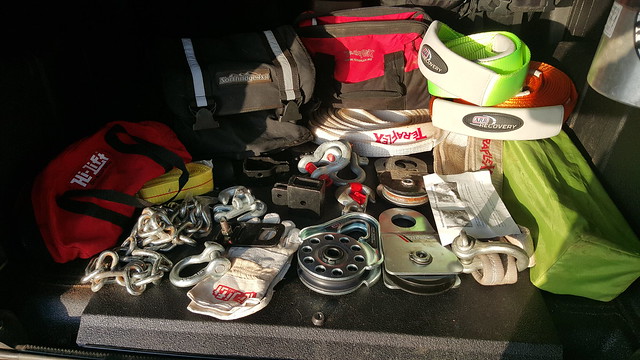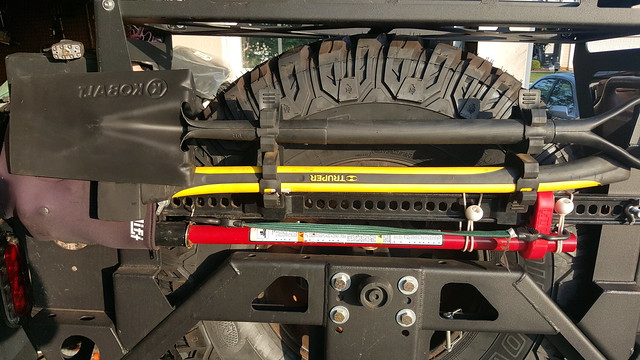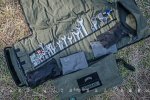
All but the chainsaw, tire chains, drills, FSM, and spare parts are kept in the truck at all times.
From the Top Left
- Axe
. *I would recommend a single bit axe, so you can drive it out with a hammer if you get it stuck.
- Hatchet
- 48" Cast Hi-Lift
- Ice Scraper, Squeegie, Snow Brush
. *This is very useful for the squeegie so you can get mud off the windshield without using all of you washer fluid.
- Spade
- 18v Milwaukee Impact Driver
- 18v Milwaukee Drill
- 18v Milwaukee Spare Battery
- 50+ piece Impact Driver Bit Set
- 50+ piece Milwaukee Drill Bit Set
. *These actually ended up being extremely helpful.
. *Was able to repair a severe failure on the suspension on the Ford on our most recent trip. When I get that trip report done, I'll put a link to it.
- 149 piece Crescent Tool Kit
. *I like this kit so much, I bought two and keep one in my car as well. Very recommend.
- 20' #2 jumper cables
- (2) 3/8" Snatch Blocks
. *These are usually used for logging and have grease-able fittings.
- (6) 3/4" Shackles
- (1) 1/2" Shackle
. *This is only used when pulling little cars out of the snow when their recovery point is too small for my 3/4" shackles.
- 4 ton Hydraulic Bottle Jack
- Hitch Mount 3/4" Shackle w/ 5/8" Class IV locking SS pin
- 4-way Lug Wrench
- (4) 10 mm Diamond Pattern Tire Chains
. *Highly recommend these diamond pattern (European Hoop Style) chains as opposed to the ladder type chains. They stay a lot tighter on the tire than the ladder type do; and therefore don't destroy your fender-wells. They do come in different sizes (thickness). So make sure you get the thicker ones. Also recommend doubling up on the rubber-tensioners. Also, if you get the tensioners with hooks on them, make sure that you put them on with the hooks pointing out... learned that one the hard way.
- (3) 6' 6400 lb lifting straps (Harbor Freight)
- (3) 30' 27,000 lb Poly Recovery Straps (Harbor Freight)
- Husky 12v Inflator
. *This will go away when I get on-board air
- Hitch Tray Mounted Smittybilt XRC8 8000lb winch w/ Tweco Welding Plugs
- (Not Pictured) 30' 3/8" Winch Extension Cable
- (Not Pictured) Deer Skin Dedicated Winching Gloves
- Fire Extinguisher
- Road Flare Kit
- Paper Towels
- General Tool Box
. - ATF Funnel
. - Regular Funnel
. - Ball Peen Hammer
. - Multimeter
. - 16ga and 12ga Electrical Wire
. - Solder
. - 10" DeWalt Crescent Wrench
. - Channel Locks
. - High Temp RTV Sealant
. - 2-part 30-min Epoxy
. - Flexible Neck Butane Lighter
. - Duct tape
. - Electrical Tape
. - Utility Knife
. - 10" Pipe Wrench
. - 5/8" Alan Key for 1/2" socket (Lowering Spare Tire)
. - Socket for Axle Nuts
. - Wire Stripper
. - WD-40
. - Strapwrench
. - Spare Headlight, Tail-light, Clearance Light bulbs.
. - Spare Fuses
. - Maglight 2AA Penlight
. - Spare U-Joints
. - C-Clamp
- Safety Glasses
. *These are actually very nice to have when you're working under the truck and there is mud, dust, and dirt falling in your face.
- Factory Service Manual
- 100' 5/8" Braided Poly Rope
- (Not Pictured) 50' 1/4" Poly Chord
- PoulanPro 140 Chainsaw
. *Would really like a 20" Stihl. But I found this almost brand-new at a garage sale for $30.
- Serpentine Belt
- (2) Spark Plug Wires
- Spark Plug
- Radiator Hose
- 4D LED Maglite
- Multipack of Zip-Ties
- Full First-Aid kit
- Hand Warmers
. *It's probably a 1 in a 1000 chance, but I blew a radiator hose when it was -10 F and had to wait about an hour for a tow home. Would very much have liked to have these. Will never not have these in the truck again.
(Additional Not Pictured)
- 2 quarts Oil
. *I've heard a lot of critique for carrying replacement fluids on the trail. The main argument is that carrying enough oil to replace all of your oil in the event of a damaged oil pan takes up a lot of room and carrying less than that won't do you any good. However, when I first bought my truck, it ran perfectly fine for several months before I changed the oil for the first time. When I drained the oil, there was little more than 1/2 a quart in it. So it is possible for it to run without severe damage with much less than 5 quarts.
- 1 quart gear oil
- 1 quart ATF
- 1 quart Bar/Chain Oil
- 1 Gallon 2-Cycle Gas Mix
- (6) Ratchet Tie-Down Strap





